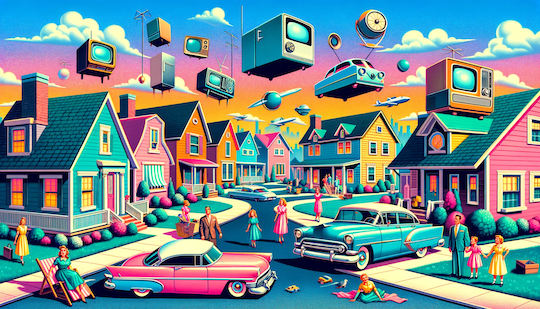
Life After WWIII
Posted May 09, 2024
Chris Campbell
WWII was a good time to survive.
After the deprivations and sacrifices of World War II, Americans were eager to enjoy the peace and prosperity of the postwar era.
Between 1946 and 1960, the US saw a huge expansion in the consumption of goods and services. In just 14 years, the Gross National Product rose by 36% and personal consumption expenditures went up by 42%.
During the war years, consumer production was scanty as factories were converted to military purposes.
This created pent-up demand for things like cars, household appliances, and clothing that could finally be satisfied after 1945. With 16 million servicemen returning home, getting jobs, and starting families, the demand was huge.
Owning a modern suburban home loaded with appliances and a car in the driveway became a symbol of affluence and the American Dream.
The rise of television, advertising, and new mass marketing techniques promoted a cultural shift towards consumerism and keeping up with fads and trends. Advertisements promised that having the latest products would bring happiness, status and belonging.
It even became a political talking point.
Purchasing consumer goods was patriotic -- a demonstration of superiority over communist countries.
From all of this, the era also saw the growth of the behemothic corporation and the slow death of the relatively nanoscopic small business.
This was the Zeitgeist of the latter half of the 20th century.
BUT, as mentioned yesterday, things tend to run the other way soon enough. And we might be seeing a turn in the opposite direction…
Generational values are the major driver. Lockdowns and inflation have been accelerants.
With fears of World War III looming…
Could this be a good time to survive?
And… is this THE catalyst for the rise of crypto?
Let’s dig in.
Inflation as an Accelerator
The common stereotype is that younger generations show a stronger desire for “participatory engagement” over “passive consumerism.”
Nowhere is that more evident than in the so-called sharing economy. Although its mainstream presence isn’t as strong as it once was, as Uber and Airbnb sullied its reputation, it’s still kicking behind the scenes.
While inflation is ravaging, sharing economy apps and models are seeing a resurgence.
Too Good To Go connects consumers with restaurants and stores, helping reduce food waste while providing discounted meals. JustPark allows people to monetize their unused parking spaces, while WeFi creates a global community of Wi-Fi sharers.
Stashbee transforms idle storage space into affordable solutions for those in need, and CrowdMed harnesses the power of crowdsourcing to provide medical advice and potential diagnoses.
As someone who works on his cars, a welcome addition is the rise of tool libraries. Some of the tools I need, I use once or twice a year. Why do I want to buy them?
You might be wondering…
What does this have to do with crypto?
Well, if the zeitgeist is a trend toward more participatory models that cut out the middleman…
The decentralized, peer-to-peer nature of crypto does seem well-suited to facilitate transactions in a sharing economy model -- and without the need for much-maligned intermediaries.
Participatory Capital Formation
As mentioned yesterday, blockchain technologies are "generative" -- they can create entirely new markets, services, and economic activity that did not exist before.
In a recent Lightspeed interview, serial entrepreneur Josh Rosenthal described crypto as “participatory capital formation.”
People can invest, co-create value, and have more direct governance stakes in the technologies and platforms they engage with.
A few key points from the interview:
→ Crypto enables new forms of participatory capital formation - ways of pulling money together to build businesses that wouldn't otherwise be possible. It allows entrepreneurs to bypass traditional modes of centralized funding.
→ Tokens and crypto networks can incentivize and monetize participation in building out new infrastructure and services from essentially nothing, solving "cold start" problems without massive upfront capital.
→ It has the potential to open up access to early-stage investing/ownership that was previously restricted. Now anyone can earn/invest time and attention versus just having surplus cash.
→ This allows more people to participate in the upside of innovative new business models and networks, rather than value just accruing to capital holders.
→ Tokenized reputation systems and collateral can reduce the risk of bad actors.
→ It's anti-inflationary for the middle class by enabling them to grow wealth through earning/investing rather than just being "products" for big tech companies.
→ Historically, similar shifts in capital formation models faced resistance but enabled more people to do vocational work they cared about rather than subsisting on feudal manors.
→ The intellectual talent now building in this space suggests immense innovative potential beyond just financial use cases as more creators are empowered.
In short, if the word “crypto” freaks you out, here’s one better:
Participatory capital formation.
This is different from traditional technologies or business models that may optimize or expand an existing market, but don't fundamentally create a new one from scratch.
While pre-existing scarcity-based business models aim to release products in a controlled way to maximize rents, crypto's generative model drives towards maximizing participation, ownership and abundance of what can be created on these open networks.
Here’s the thing:
A Good Time to Survive
Living in interesting times can be a curse or a boon.
We tend to take the latter view.
And it only takes ONE asymmetrical bet to make retirement money.
I’ve just shown you how crypto could turn Wall Street inside out…
But NOBODY sees what’s coming when you throw AI in the mix.
